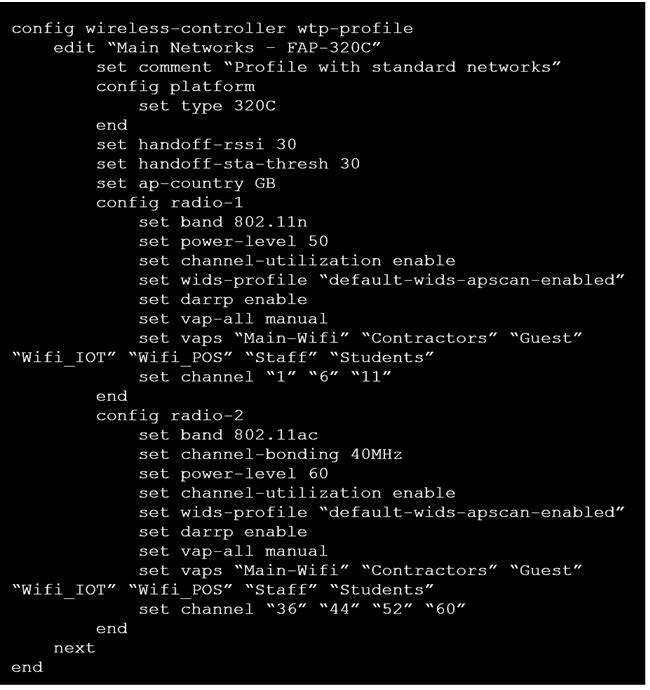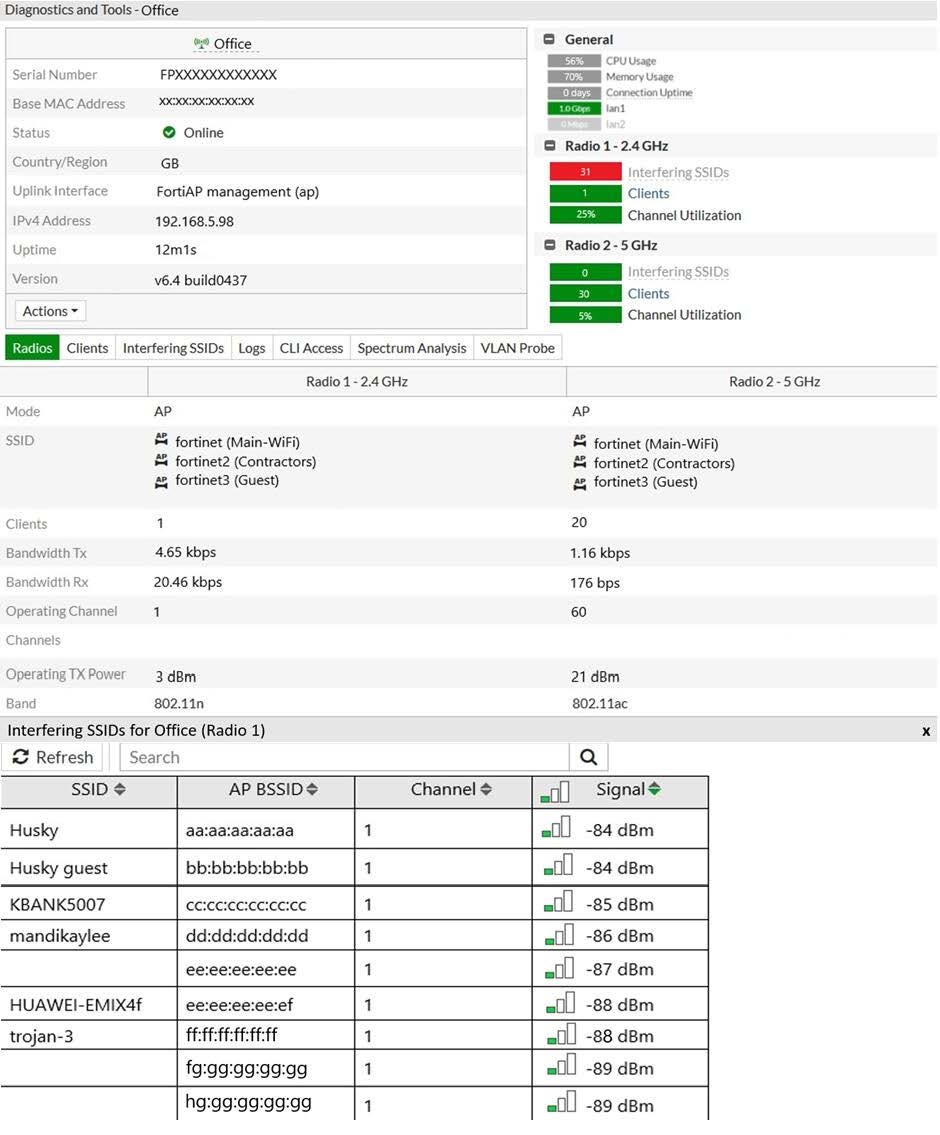Exam Details
Exam Code
:NSE6_FWF-6.4Exam Name
:Fortinet NSE 6 - Secure Wireless LAN 6.4Certification
:Fortinet CertificationsVendor
:FortinetTotal Questions
:32 Q&AsLast Updated
:Aug 12, 2025
Fortinet Fortinet Certifications NSE6_FWF-6.4 Questions & Answers
-
Question 21:
You are investigating a wireless performance issue and you are trying to audit the neighboring APs in the PF environment. You review the Rogue APs widget on the GUI but it is empty, despite the known presence of other APs. Which configuration change will allow neighboring APs to be successfully detected?
A. Enable Locate WiFi clients when not connected in the relevant AP profiles.
B. Enable Monitor channel utilization on the relevant AP profiles.
C. Ensure that all allowed channels are enabled for the AP radios.
D. Enable Radio resource provisioning on the relevant AP profiles.
-
Question 22:
Which two configurations are compatible for Wireless Single Sign-On (WSSO)? (Choose two.)
A. A VAP configured for captive portal authentication
B. A VAP configured for WPA2 or 3 Enterprise
C. A VAP configured to authenticate locally on FortiGate
D. A VAP configured to authenticate using a radius server
-
Question 23:
When enabling security fabric on the FortiGate interface to manage FortiAPs, which two types of communication channels are established between FortiGate and FortiAPs? (Choose two.)
A. Control channels
B. Security channels
C. FortLink channels
D. Data channels
-
Question 24:
Part of the location service registration process is to link FortiAPs in FortiPresence.
Which two management services can configure the discovered AP registration information from the FortiPresence cloud? (Choose two.)
A. AP Manager
B. FortiAP Cloud
C. FortiSwitch
D. FortiGate
-
Question 25:
Which two phases are part of the process to plan a wireless design project? (Choose two.)
A. Project information phase
B. Hardware selection phase
C. Site survey phase
D. Installation phase
-
Question 26:
When configuring a wireless network for dynamic VLAN allocation, which three IETF attributes must be supplied by the radius server? (Choose three.)
A. 81 Tunnel-Private-Group-ID
B. 65 Tunnel-Medium-Type
C. 83 Tunnel-Preference
D. 58 Egress-VLAN-Name
E. 64 Tunnel-Type
-
Question 27:
Which two statements about background rogue scanning are correct? (Choose two.)
A. A dedicated radio configured for background scanning can support the connection of wireless clients
B. When detecting rogue APs, a dedicated radio configured for background scanning can suppress the rogue AP
C. Background rogue scanning requires DARRP to be enabled on the AP instance
D. A dedicated radio configured for background scanning can detect rogue devices on all other channels in its configured frequency band.
-
Question 28:
Refer to the exhibits. Exhibit A.

Exhibit B.

Exhibit C.

A wireless network has been installed in a small office building and is being used by a business to connect its wireless clients. The network is used for multiple purposes, including corporate access, guest access, and connecting point-of-sale and IoТ devices.
Users connecting to the guest network located in the reception area are reporting slow performance. The network administrator is reviewing the information shown in the exhibits as part of the ongoing investigation of the problem. They show the profile used for the AP and the controller RF analysis output together with a screenshot of the GUI showing a summary of the AP and its neighboring APs.
To improve performance for the users connecting to the guest network in this area, which configuration change is most likely to improve performance?
A. Increase the transmission power of the AP radios
B. Enable frequency handoff on the AP to band steer clients
C. Reduce the number of wireless networks being broadcast by the AP
D. Install another AP in the reception area to improve available bandwidth
-
Question 29:
When configuring Auto TX Power control on an AP radio, which two statements best describe how the radio responds? (Choose two.)
A. When the AP detects any other wireless signal stronger that -70 dBm, it will reduce its transmission power until it reaches the minimum configured TX power limit.
B. When the AP detects PF Interference from an unknown source such as a cordless phone with a signal stronger that -70 dBm, it will increase its transmission power until it reaches the maximum configured TX power limit.
C. When the AP detects any wireless client signal weaker than -70 dBm, it will reduce its transmission power until it reaches the maximum configured TX power limit.
D. When the AP detects any interference from a trusted neighboring AP stronger that -70 dBm, it will reduce its transmission power until it reaches the minimum configured TX power limit.
-
Question 30:
Which factor is the best indicator of wireless client connection quality?
A. Downstream link rate, the connection rate for the AP to the client
B. The receive signal strength (RSS) of the client at the AP
C. Upstream link rate, the connection rate for the client to the AP
D. The channel utilization of the channel the client is using
Related Exams:
FCP_FAZ_AD-7.4
FCP - FortiAnalyzer 7.4 AdministratorFCP_FGT_AD-7.4
FCP - FortiGate 7.4 AdministratorFCP_FGT_AD-7.6
FortiGate 7.6 Administrator FCP_FGT_AD-7.6FCP_WCS_AD-7.4
FCP - AWS Cloud Security 7.4 AdministratorFCSS_EFW_AD-7.4
FCSS - Enterprise Firewall 7.4 AdministratorFCSS_NST_SE-7.4
FCSS - Network Security 7.4 Support EngineerFCSS_SASE_AD-24
FCSS - FortiSASE 24 AdministratorNSE4_FGT-5.6
Fortinet NSE 4 - FortiOS 5.6NSE4_FGT-6.0
Fortinet NSE 4 - FortiOS 6.0NSE4_FGT-6.4
Fortinet NSE 4 - FortiOS 6.4
Tips on How to Prepare for the Exams
Nowadays, the certification exams become more and more important and required by more and more enterprises when applying for a job. But how to prepare for the exam effectively? How to prepare for the exam in a short time with less efforts? How to get a ideal result and how to find the most reliable resources? Here on Vcedump.com, you will find all the answers. Vcedump.com provide not only Fortinet exam questions, answers and explanations but also complete assistance on your exam preparation and certification application. If you are confused on your NSE6_FWF-6.4 exam preparations and Fortinet certification application, do not hesitate to visit our Vcedump.com to find your solutions here.